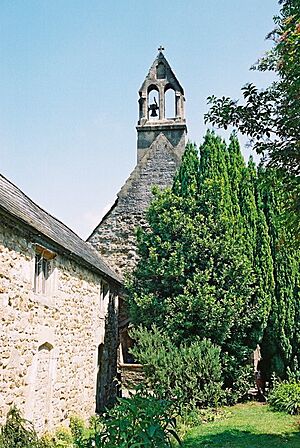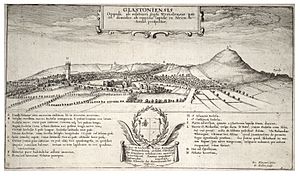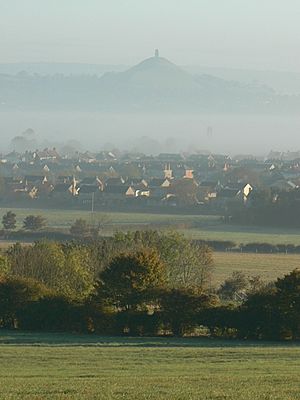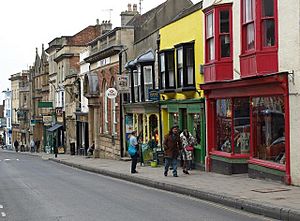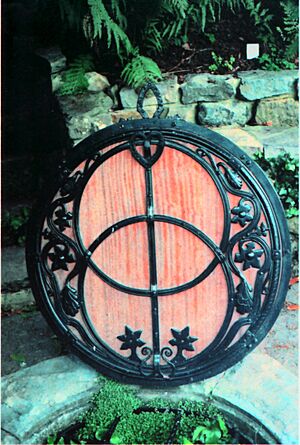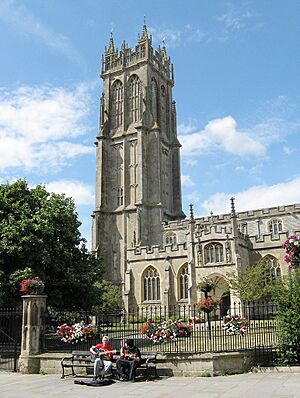Glastonbury facts for kids
Quick facts for kids Glastonbury |
|
|---|---|
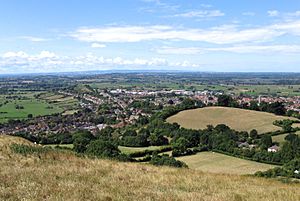 A view of Glastonbury from the Tor |
|
| Population | 8,932 |
| OS grid reference | ST501390 |
| Civil parish |
|
| Unitary authority |
|
| Ceremonial county | |
| Region | |
| Country | England |
| Sovereign state | United Kingdom |
| Post town | Glastonbury |
| Postcode district | BA6 |
| Dialling code | 01458 |
| Police | Avon and Somerset |
| Fire | Devon and Somerset |
| Ambulance | South Western |
| EU Parliament | South West England |
| UK Parliament |
|
Glastonbury is a historic town in Somerset, England. It sits on a dry spot in the low-lying Somerset Levels, about 23 miles (37 km) south of Bristol. In 2011, about 8,932 people lived here. Glastonbury is very close to the town of Street, which has grown to be larger.
People have lived in the Glastonbury area since the Neolithic (New Stone Age) period. This is known from ancient wooden pathways like the Sweet Track. The Glastonbury Lake Village was an Iron Age settlement near the River Brue. It dates back to the Bronze Age.
For 700 years, Glastonbury Abbey was very important to the town. It was one of England's most significant abbeys. In 1016, Edmund Ironside was crowned King of England there. Many old buildings in Glastonbury, like the Tribunal and the George Hotel, were connected to the abbey. The Church of St John the Baptist was built in the 15th century.
Glastonbury became a trading hub. This led to the building of the market cross, the Glastonbury Canal, and a railway station. Today, the Brue Valley Living Landscape is a nature project nearby. The Ham Wall National Nature Reserve is also close.
Glastonbury is famous for its New Age beliefs and spiritual ideas. Many myths and legends are linked to Glastonbury Tor. These stories involve Joseph of Arimathea, the Holy Grail, and King Arthur. The Glastonbury Festival, a huge music event, is held nearby in Pilton.
Contents
- Exploring Glastonbury's Past
- Myths and Legends of Glastonbury
- How Glastonbury is Governed
- Glastonbury's Landscape and Weather
- Glastonbury's Economy
- Famous Landmarks in Glastonbury
- Getting Around Glastonbury
- Local News and Media
- Schools and Learning
- Places of Worship and Faith Groups
- Sports and Activities
- Culture and Festivals
- Famous People from Glastonbury
- Twin Towns
- Freedom of the Town
- The Key of Avalon
- See also
Exploring Glastonbury's Past
Ancient Times: Early Settlements
The area around Glastonbury was once covered by water. Around 7,000 BCE, the sea level rose, flooding the valleys. Early people lived in seasonal camps on higher ground. Later, Neolithic people built wooden pathways.
- The Sweet Track: An Ancient Road
The Sweet Track is one of the oldest engineered roads ever found. It was built around 3807 or 3806 BCE. This wooden track crossed marshy land for about 2,000 meters (1.2 miles). It was made of ash, oak, and lime poles driven into the wet ground, supporting a walkway of oak planks. An even older track, the Post Track, was found beneath it, dating back to 3838 BCE.
- Glastonbury Lake Village: Life in the Iron Age
The Glastonbury Lake Village was an Iron Age village. It was located near the River Brue, about 3 miles (5 km) northwest of Glastonbury. This village was home to about 100 people. They lived in houses made of hazel and willow, covered with reeds. The village was built on an artificial foundation of timber and clay. It was used from about 300 BCE until the early Roman period, around 100 CE.
The Middle Ages: Abbey and Town Growth
The name Glastonbury comes from Glestingaburg, first recorded in the 7th century. The "burg" part might mean a fortified place or a monastic area. The "Glestinga" part is a mystery.
One story says the Tor was named after a "glassy mansion" where spirits of the dead went. This comes from old Druid myths. Later, a chapel and church were built on the Tor, dedicated to St. Michael.
Glastonbury Abbey became very powerful. Centwine of Wessex was an early supporter in the 7th century. In 1016, King Edmund Ironside was buried at the abbey. The abbey owned much land and was very important until the dissolution of the monasteries in 1539.
Beckery, now a suburb, was once a village. In the 7th and 8th centuries, it had a small monastic community. In 2016, archaeologists found 50 to 60 skeletons there, believed to be monks from the 5th or 6th century.
The St Margaret's Chapel was built in the 1070s. It was first a hospital, then almshouses for the poor. The building we see today dates from 1444.
During the Middle Ages, Glastonbury relied on the abbey and the wool trade. A Saxon-era canal connected the abbey to the River Brue. Richard Whiting, the last Abbot of Glastonbury, was executed in 1539 during the dissolution of the monasteries.
Modern Times: Trade, Tourism, and Change
In 1693, Glastonbury, Connecticut, in the USA, was founded and named after the English town.
Glastonbury received its town charter in 1705. Trade grew as the surrounding marshlands were drained. The Glastonbury Canal opened in the early 19th century, boosting trade. However, by the mid-19th century, the canal faced problems and competition from new railways.
The canal closed in 1854, and the railway opened that same year. The main railway line to Glastonbury closed in 1966.
In the Northover area, factories made sheepskins, woollen slippers, and shoes. The shoe company C&J Clark in Street was a big employer. Today, Clarks still has its headquarters in Street, but shoes are no longer made there. Instead, a shopping village called Clarks Village opened in 1993.
Over the 19th and 20th centuries, tourism grew. People came to see the abbey and learn about the town's mystical stories. This helped Glastonbury's economy and led to more people living there.
Myths and Legends of Glastonbury
Glastonbury is famous for its many myths and legends. These stories often involve Joseph of Arimathea, the Holy Grail, and King Arthur.
King Arthur and the Holy Grail
Many legends connect Glastonbury to King Arthur and his queen, Guinevere. Some historians believe that the monks of Glastonbury Abbey created these stories in 1184. This was after a big fire damaged the abbey, and they needed money for repairs. The stories helped make the abbey more famous and attract visitors.
In 1191, monks claimed to have found the graves of Arthur and Guinevere at the abbey. However, many experts think this was a trick to make the abbey seem more important.
The legend of Joseph of Arimathea bringing the Holy Grail to Britain was made popular by a French poet in the 13th century. This story says Joseph collected Jesus's blood in a cup, which became the Holy Grail. He then brought it to Glastonbury.
The Glastonbury Thorn
The legend says that when Joseph of Arimathea arrived in Glastonbury, he stuck his staff into the ground. It miraculously flowered into the Glastonbury Thorn. This story explains a special type of hawthorn tree that grows near Glastonbury. It flowers twice a year, once in spring and again around Christmas.
The original Holy Thorn was cut down during the English Civil War. New thorns have been planted since. A sprig of the thorn is still sent to the Queen each year.
The Glastonbury Zodiac
In 1934, an artist named Katherine Maltwood suggested that a giant landscape zodiac exists around Glastonbury. She believed that features in the landscape, like roads and streams, formed a map of the stars. She thought ancient Sumerians created it around 2700 BCE.
However, studies by archaeologists have shown that this idea is not true. Many of the "zodiac" features are actually much newer, like roads built in the 1700s or drainage ditches. There is no scientific evidence to support the idea of an ancient zodiac in Glastonbury.
How Glastonbury is Governed
Glastonbury has a town council with 16 members. They meet at the Glastonbury Town Hall, which was built in 1814.
For local government, Glastonbury is part of Somerset Council. This is a larger council that handles services for the whole area.
Glastonbury has its own fire station, run by Devon and Somerset Fire and Rescue Service. Police services are provided by Avon and Somerset Constabulary. There are also doctors' surgeries and a community hospital.
Glastonbury is twinned with two places: Patmos, an island in Greece, and Lalibela, a town in Ethiopia.
Glastonbury's Landscape and Weather
The Tor is a famous hill in Glastonbury. At its top is a distinctive tower, which is the remains of an old church. From the Tor, you can see amazing views of the Somerset area. The Tor is 158 meters (518 feet) above sea level. It helps you see how Glastonbury was once an island, surrounded by water. In winter, the nearby marshlands often flood, making it look like an island again.
The low-lying, damp ground can sometimes create a Fata Morgana. This is a type of mirage where light bends through different air temperatures, making distant objects look distorted or appear to float. The name Fata Morgana comes from Morgan le Fay, a powerful sorceress in the King Arthur legends.
Glastonbury is less than 1 mile (1.6 km) from Street, across the River Brue. In King Arthur's time, the Brue formed a lake south of Glastonbury. This lake is sometimes said to be the home of the Lady of the Lake.
The Brue Valley Living Landscape is a project to protect nature in the Somerset Levels. It helps restore habitats and supports wildlife. The Ham Wall National Nature Reserve is also nearby. It's a wetland habitat with reedbeds and open water, home to birds like the bearded tit and the bittern.
Glastonbury has a mild and wet climate, like the rest of South West England. The average temperature is about 10°C (50°F). Summers are warm, with highs around 21°C (70°F). Winters are cool, with lows around 1°C (34°F). It rains about 700 mm (28 inches) per year.
Glastonbury's Economy
Glastonbury is a popular place for religious tourism and pilgrimage. The town centre has many unique shops, especially those selling alternative and spiritual items.
The old Morlands factory site, which used to make sheepskin products, is being redeveloped. This project aims to create new jobs and support local unemployed people.
Famous Landmarks in Glastonbury
Glastonbury has many historic buildings. About 170 buildings in the town's conservation area are listed for their special historical or architectural importance.
- The Tribunal
The Tribunal was once a medieval merchant's house. It was used as a courthouse for the abbey. Today, it is a museum with items from the Glastonbury Lake Village. It also houses the town's tourist information centre.
- The Market Cross
The octagonal Market Cross was built in 1846.
- The George Hotel and Pilgrims' Inn
The George Hotel was built in the late 15th century. It provided lodging for visitors to Glastonbury Abbey. It is a very important historic building.
- Somerset Rural Life Museum
The Somerset Rural Life Museum shows the history of farming and life in Somerset. It is located in buildings that include a 14th-century barn. This barn belonged to Glastonbury Abbey and was used to store crops.
- Chalice Well
The Chalice Well is a holy spring at the foot of the Tor. It has been used for at least two thousand years. The water has a reddish color because of iron deposits. Many people believe the water has healing powers. The well is often seen as a symbol of the female side of nature, while the Tor represents the male. It is a popular spot for pilgrims and is now a World Peace Garden.
- White Spring
Near the Chalice Well is the "White Spring." Its water is white with calcite. Some people believe the red water of Chalice Well has male qualities, and the white water of White Spring has female qualities. Both springs come from under the Tor and are thought to have healing properties. The building covering the White Spring was built in 1872 and is now a "water temple."
Getting Around Glastonbury
The Glastonbury Canal used to run for over 14 miles (23 km) from Glastonbury to Highbridge. It was used for trade in the early 19th century but closed when the railway arrived.
Glastonbury and Street railway station was a large station on the old Somerset & Dorset Joint Railway. It closed in 1966. Today, the site is a timber yard.
The main road in Glastonbury is the A39. It connects the town to Wells and Street. Local bus services connect Glastonbury to Bristol, Bridgwater, Yeovil, and Taunton. There is also a coach service to London.
Local News and Media
Local TV news for Glastonbury comes from BBC West and ITV West Country.
Local radio stations include BBC Radio Somerset and Heart West. Worthy FM broadcasts during the Glastonbury Festival. GWS Radio is a community radio station.
Local newspapers include the Mid Somerset Series and the Somerset County Gazette.
Schools and Learning
Glastonbury has several schools for younger children. For secondary education, students attend St Dunstan's School. It is named after St. Dunstan, a famous abbot of Glastonbury Abbey who became the Archbishop of Canterbury. The school was built in 1958 and has special facilities for arts and students with special needs.
Strode College in Street offers courses for students aged 16 and older, as well as adult education.
Places of Worship and Faith Groups

Glastonbury may have been a religious site even before Christianity. Glastonbury Abbey was founded by Britons, possibly in the early 7th century. Later legends claimed it was founded by Joseph of Arimathea in the 1st century. This legend links the abbey to the Holy Grail and King Arthur.
The abbey was destroyed during the Dissolution of the Monasteries. Today, you can see the ruins of the Abbot's Kitchen and the Lady Chapel.
Glastonbury also has strong links to Ireland. It is believed that St. Patrick and St. Brigid visited the area. There are chapels named after them.
The Church of St Benedict was rebuilt around 1520. The Church of St John the Baptist is a large and beautiful church from the 15th century. It is known for its tall tower.
Over the centuries, many different Christian groups have built churches and meeting houses in Glastonbury. These include Quakers, Baptists, Methodists, and others.
The Catholic Church of Our Lady St Mary of Glastonbury was built in 1939. It has a special statue of Mary.
Glastonbury is also home to other faith groups. The Glastonbury Order of Druids was formed in 1988. Sufism, a mystical branch of Islam, has been present in Glastonbury for a long time. The pagan Glastonbury Goddess Temple opened in 2002.
In 2012, it was reported that Glastonbury had about seventy different faith groups. This shows how diverse and open the town is to different spiritual beliefs.
Sports and Activities
Glastonbury has a local football team, Glastonbury F.C.. They have won the Western Football League title three times.
Glastonbury Cricket Club plays at the Tor Leisure Ground. The town is also on the route of the Samaritans Way South West, a long-distance walking path.
Culture and Festivals
Glastonbury has inspired many books and stories. It is a setting in the Warlord Chronicles by Bernard Cornwell, which are about King Arthur. The novel A Glastonbury Romance by John Cowper Powys is also set here.
The Children's World charity started in Glastonbury. It helps children, especially those with special needs, through drama and creative play. They also run the Glastonbury Children's Festival every August.
Glastonbury has a local Brass Band called Glastonbury Brass. They are a talented group and have even been featured on music albums.
Glastonbury is the final stop for the annual November West Country Carnival, a colourful parade with illuminated floats.
Glastonbury Festival: A World-Famous Event
The first Glastonbury Festivals were cultural events held from 1914 to 1926. They were started by composer Rutland Boughton. He wanted to create a summer school and music festival based on peaceful ideas. Glastonbury was chosen because of its links to King Arthur and its ancient history.
The modern Glastonbury Festival of Performing Arts began in 1970. It is now the largest open-air music and performing arts festival in the world. Even though it's named after Glastonbury, it takes place at Worthy Farm, about 6 miles (10 km) east of the town. The festival is famous for its music, but it also features dance, comedy, theatre, circus, and other arts. In 2007, over 700 acts performed on more than 80 stages, and 177,000 people attended.
Glastonbury Extravaganza
The Glastonbury Extravaganza is an annual music event held at Glastonbury Abbey since 1996. It is a special thank you from Glastonbury Festival organiser Michael Eavis to the local community.
Famous People from Glastonbury
Many interesting people have been born or lived in Glastonbury.
- Peter King, 1st Baron King was a recorder of Glastonbury in 1705.
- Thomas Bramwell Welch, who discovered the pasteurisation process for grape juice, was born here in 1825.
- The writer and occultist Dion Fortune lived and is buried in Glastonbury.
- Geoffrey Ashe, a historian known for his work on local legends, lived in Fortune's old house.
- Eckhart Tolle, a spiritual teacher, lived in Glastonbury in the 1980s.
- Eileen Caddy, a spiritual teacher and founder of the Findhorn Foundation, claimed to have heard the "voice of God" while in Glastonbury.
- Rutland Boughton, an English composer, moved to Glastonbury in 1911 and started the country's first national summer music school.
- Gary Stringer, the lead singer of the rock band Reef, grew up here.
- Arabella Churchill, one of the founders of the Glastonbury Festival, lived in the town.
- Formula 1 driver Lando Norris grew up in Glastonbury.
Twin Towns
Glastonbury is twinned with:
Freedom of the Town
The "Freedom of the Town" is a special honour given to people or groups.
- Michael Eavis: On May 3, 2022, the founder of the Glastonbury Festival was made a Freeman of Glastonbury. He started the festival in 1970.
The Key of Avalon
This award was created in 2022 by the Glastonbury Town Council. The first person to receive it was Prem Rawat, an international peace advocate.
See also
 In Spanish: Glastonbury para niños
In Spanish: Glastonbury para niños



